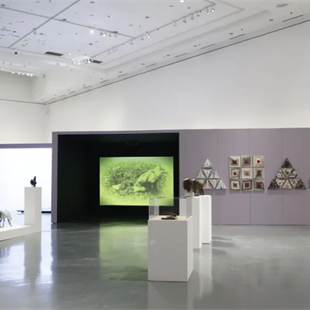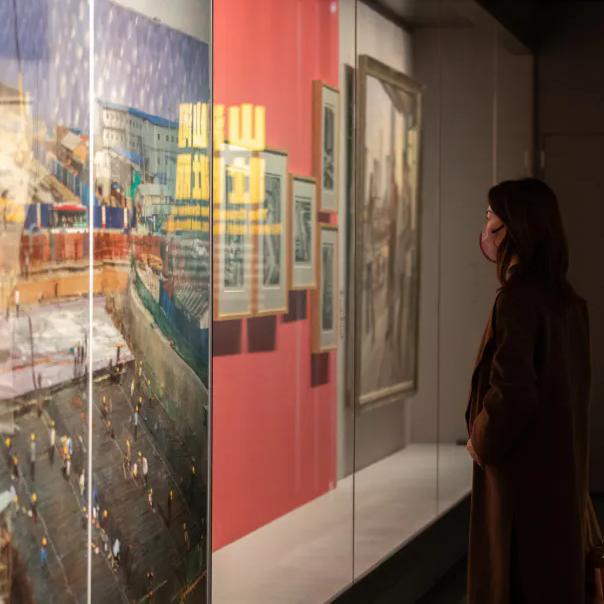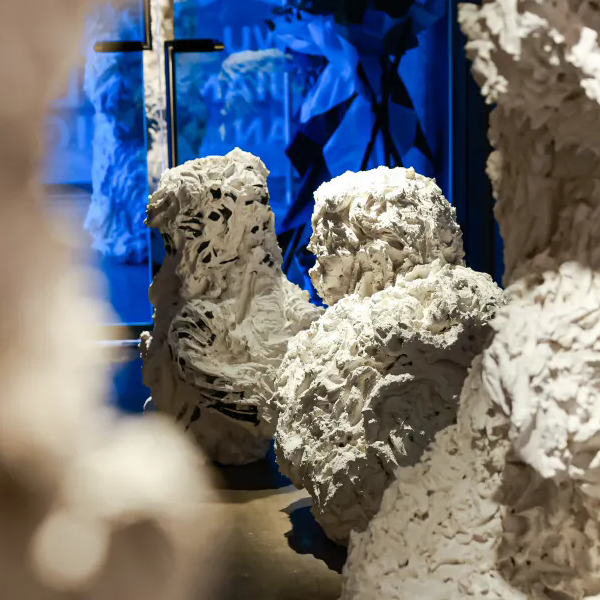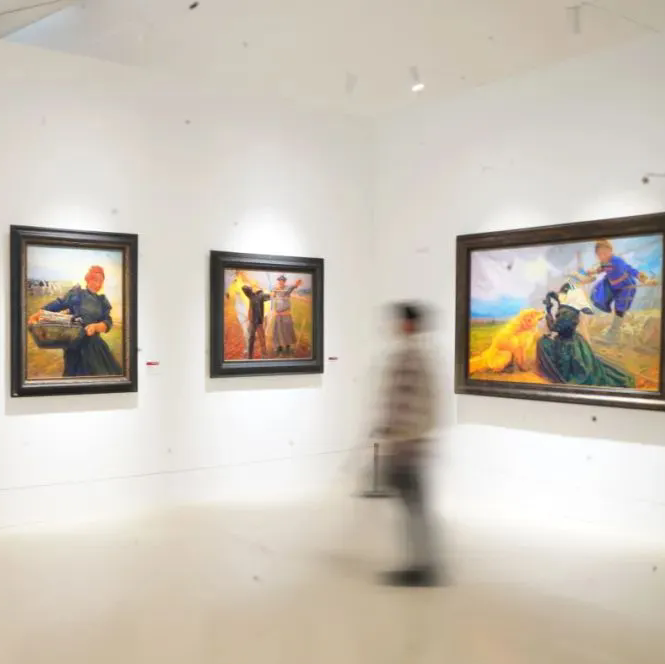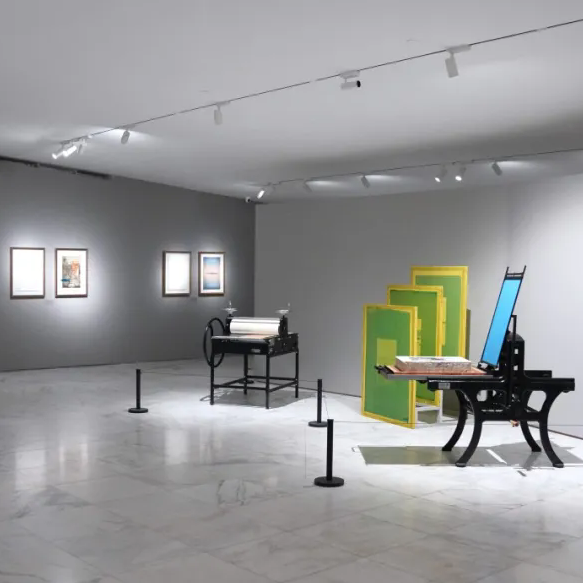 Exhibition View of “Jin Rilong: Inner Voice in the Universe”
Exhibition View of “Jin Rilong: Inner Voice in the Universe”
Following “Jin Rilong Art Exhibition” held at Prince Kung’s Mansion in Beijing in 2018 and “SELF-RESTRAINT & HORIZON: Twenty Years of Jin Rilong’s Abstract Art” presented at Shandong Art Museum in 2020, “Jin Rilong: Inner Voice in the Universe” was unveiled at the One Art Museum in Beijing on March 7, 2023. With fifty artworks that represent Jin Rilong’s oeuvre, the exhibition intends to present the latest creative stage of the artist over the past five years.


 Exhibition View of “Jin Rilong: Inner Voice in the Universe”
Exhibition View of “Jin Rilong: Inner Voice in the Universe”
Jin Rilong has travelled freely using various identities for a long time. In 1982, he attained the Gold Award in the First National Exhibition of Minority Fine Arts with his work “Grandma” and shot to fame, which was encouraged and appreciated by Jiang Feng, the then President of the Central Academy of Fine Arts. When he was 20 years old, Jin was admitted to the Central Academy of Fine Arts. His study experience at the First Studio in the Department of Oil Painting at the Central Academy of Fine Arts did not only lay a solid foundation for him, but it also made sure he was more firmly attached to painting. After he obtained a master’s degree and a doctor’s degree in Seoul National University and Hongik University in South Korea, Jin returned to China and has taught at the Central Academy of Fine Arts. In addition to his busy teaching and administrative work, Jin Rilong is adept at “squeezing time” for creation. With his unremitting creative passion, he has accumulated a lot of works in oils. With a rich life experience and professional cross-disciplinary experience, Jin Rilong has not changed his original intention in painting. In recent years, he has more enthusiastically been devoted to artistic creation and found his unique way of nonrepresentational painting.



The Opening Ceremony of “Jin Rilong: Inner Voice in the Universe”
All the fifty artworks by Jin Rilong were divided into four sections according to the four internally connected classic Chinese concepts of “heaven”, “earth”, “heart”, and “voice”. Taking the sequence of his creation as the context, Jin’s creations before 2018 are shown on the ground floor, while his creations after 2019 are presented on the second floor of the One Art Museum.
As a brave artist who continuously pursues transformation in his creation, Jin Rilong’s creative career is almost synchronized with China’s reform and opening up. The artist feels the same pulse of the epoch and thus his creations truthfully reflect the transition in the Chinese social environment and the epochal concepts. From the perspective of Fan Di’an, President of the Central Academy of Fine Arts, it is the “transformation” of Jin Rilong’s creative career that allows him to create a series of paintings with unique features: from learning classical oil painting, art design to abstract art, Jin Rilong’s work shows changing characteristics, and in the process, “he attributed his multiple art forms and experiences to the most appropriate state with the mind and emotions, and finally turned to the pursuit of “eternal”, that is, building a visual pattern corresponding to the soul in abstract art, which reflects a visual constant sense of order and calmness in abstract works.” [1]



The Opening Ceremony of “Jin Rilong: Inner Voice in the Universe”
Over time he has paid attention to Chinese classical art and philosophy, at the same time, his rich life experience has also endowed him with the most authentic feelings in continuous geographical migration. The spirit of traditional Chinese culture has taken root in his work, and naturally grown, or, as described by curator Zhang Zikang, Director of CAFA Art Museum, Jin has always been confronted with the interweaving state of international and local experience, the convergence of traditional culture and contemporary life,” to carry out his creation. The traditional Chinese art cultivation and thought that Jin has received, has naturally spread from the abstract language to the exploration of imagery and even artistic conception in the form of “retrospection.”


 Exhibition View of “Jin Rilong: Inner Voice in the Universe”
Exhibition View of “Jin Rilong: Inner Voice in the Universe”
The “heaven” referenced in the exhibition comes from the interpretation of Chinese classical philosophy. “Heaven” means “Yang”, which symbolizes all active and innovative things. “Heaven” is like a closed circle without end, and it never stops. The audience can find that a large number of strokes with momentum appear in “Thought (Heaven in Mind)” and “The Abyss” created by the artist in 1996, and the creation of “Order”, “Nocturnal”, “A Subtle Blackness”, “To Walk Alone”, “The Book of Apocalypse” in 1997, and further to “Hermitage”, “Spring Cicada” in 2016, “Practice II”, “Practice III” and so on in 2017. Beneath the calmness of the rationality and order woven by the artist, his work implies the stormy emotional tension. Dynamics and quietness, image and shape that have reached a high degree of harmony and unity in his work. “We have seen conflicts and oppositions. This is not the so-called ‘cold’ or ‘hot’ expression but a unique tension that expresses separate and overlapping texture by the contrasts between the thick and thin, various states of dying transformation. [2]
 The Abyss, Acrylic on Paper, 70cm×100cm, 1996.11
The Abyss, Acrylic on Paper, 70cm×100cm, 1996.11 Nocturnal, Acrylic on Paper, 70cm×100cm, 1997.11
Nocturnal, Acrylic on Paper, 70cm×100cm, 1997.11 Hermitage, Acrylic on Paper, 76cm×116cm, 2016.12
Hermitage, Acrylic on Paper, 76cm×116cm, 2016.12 Spring Cicada, Acrylic on Paper, 57cm×76cm, 2016.10
Spring Cicada, Acrylic on Paper, 57cm×76cm, 2016.10 Practice II, Acrylic on Paper, 76cm×116cm, 2017.10
Practice II, Acrylic on Paper, 76cm×116cm, 2017.10
Jin Rilong has mentioned in an interview that over the 25 years of his abstract exploration, he has experienced three creative stages: one is “chaos and order”, from 2018 through to 2019; the second is “restructuring image” stage; the third part is a “self-restraint” state. The exhibition has further sorted out the artist’s work based on this clue. The “earth” part, which is opposed to the freedom and dynamics of the “heaven” part, showing the rational side of the Jin Rilong’s abstract expression. In 2017, Jin Rilong’s works “Practice VI”, “The Mid-Autumn Festival of Ding You Year II”, “The Mid-Autumn Festival of Ding You Year IV”, “Mind” in 2017, “Outside”, “East”, “West” and so on in 2018, the artist searches and intends to set up his own “rules” in his paintings. Through the combination, stacking and repetition of straight lines and rectangles, he continuously looks for and strengthens the sense of order, stability, rationality, stability and righteousness in his paintings which has formed another aspect in his creation.

The Mid-Autumn Festival of Ding You Year II, Acrylic on Paper, 76cm×174cm, 2017 Mind, Acrylic on Paper, 57cm×76cm, 2017.9.9
Mind, Acrylic on Paper, 57cm×76cm, 2017.9.9 West, Acrylic on Paper, 76cm×348cm, 2018.10
West, Acrylic on Paper, 76cm×348cm, 2018.10 East, Acrylic on Paper, 76cm×348cm, 2018.10
East, Acrylic on Paper, 76cm×348cm, 2018.10
The process that he has developed from representational art to abstract art also indicates the process so that “shape” gradually disappears in his images and this happened when he studied in South Korea. The integrated creative practice of Korean artists between Western art language and the spirit of Eastern traditional art encouraged Jin Rilong to conduct his exploration of “imagery” painting which he called the result of the “revolution” from “the process of individual revolution.”
Jin Rilong’s spontaneous “imagery” painting stems from his contemporary thinking about traditional Chinese art heritage. [3] This further points to the “artistic conception” of the Chinese traditional aesthetics summarized by Wang Guowei. Jin Rilong’s abstraction or imagery painting has profoundly discussed the possibility of Chinese cultural connotation in the current field of painting.


 Exhibition View
Exhibition View
The spirituality behind “heaven” and “earth”, in the organic connection of traditional Chinese philosophy and current expressive means, constitutes a subtle confrontation in unity in the artist’s works, and achieves the harmony in the Yin and Yang balance. The Yin and Yang balance relationship originated from Chinese culture, in Yin Shuangxi’s opinion, “This high-level balance is a subtle state that abstract artists have been pursuing. His abstract art seems to be doing subtraction. Jin Rilong consciously abandons the realistic social theme and social reviews in his work, but he has more expansion and promotion in structures, strokes, materials, space, etc.”[4]. Jin Rilong has reached the Chinese classical aesthetics, especially the Confucian Eastern aesthetic realm, with his paintings and introspection thereby interacting between the aesthetic characteristics of Chinese contemporary abstract painting and the traditional Chinese humanistic spirit.
The ancient Chinese believed that the mind was the organ of thinking, and the heart and thought had a direct connection. In the classical philosophy, the “heart” further symbolizes the subjectivity of people. The sequence of the exhibition confirms the artist’s pure thoughts and purified heart.
 Festival I, Acrylic on Paper, 76cm×57cm, 2017.9
Festival I, Acrylic on Paper, 76cm×57cm, 2017.9 Festival VII, Acrylic on Paper, 76cm×57cm, 2018.10
Festival VII, Acrylic on Paper, 76cm×57cm, 2018.10 Soul, Acrylic on Canvas, 150cm×450cm, 2018.2
Soul, Acrylic on Canvas, 150cm×450cm, 2018.2
The exhibition showcases Jin’s work over the past three years, which jointly conveys his thoughts from reality and reflects reality. Zhang Zikang also tried to remind the viewer that “Inner Voice” also conveys the musicality in Jin Rilong’s abstract (imagery) painting at the same time. The spirituality that is constituted by points, lines, planes, and colors, that is, the “linked consciousness” of the so-called visual form and hearing referred by Kandinsky, which constitutes enthusiastically unrestrained rhythm or stable and rational artistic appeal in the nonrepresentational paintings of Jin Rilong.
 Constancy I, Acrylic on Canvas, 225cm×600cm, 2021
Constancy I, Acrylic on Canvas, 225cm×600cm, 2021 Constancy VIII, Acrylic on Canvas, 60cm×60cm, 2021
Constancy VIII, Acrylic on Canvas, 60cm×60cm, 2021 Constancy XV, Acrylic on Canvas, 60cm×60cm, 2022
Constancy XV, Acrylic on Canvas, 60cm×60cm, 2022 Inner Voice, Acrylic on Canvas, 160cm×160cm, 2023
Inner Voice, Acrylic on Canvas, 160cm×160cm, 2023 The Darkling Skies and Yellow Earth II, Acrylic on Canvas, 50×100cm, 2019
The Darkling Skies and Yellow Earth II, Acrylic on Canvas, 50×100cm, 2019 Self-Restraint, Acrylic on Canvas, 300×300cm, 2020
Self-Restraint, Acrylic on Canvas, 300×300cm, 2020
On the afternoon that the exhibition was unveiled, the academic seminar was held at One Art Museum which invited a number of scholars and honored guests from the Central Academy of Fine Arts, Academy of Arts & Design, Tsinghua University, and the Guangzhou Academy of Fine Arts. They jointly discussed the latest progress made by Jin Rilong in painting, the inspiration of the Chinese abstract art from Jin’s art exploration, and characteristics as well as future development of Chinese abstract art.




View of the Academic Seminar
The exhibition was hosted by the Beijing Strong Science Park Development co., LTD., organized by the One Art Museum, and it was academically chaired by Fan Di’an, Chairman of the China Artists Association and President of the Central Academy of Fine Arts. Zhang Zikang, Director, Professor, and Doctoral Supervisor of CAFA Art Museum works as the curator. The exhibition will remain on view till March 28, 2023.
Text by Mengxi, ed. and trans. by Sue/CAFA ART INFO
Image Courtesy of Li Yanci
Courtesy of the Artist and One Art Museum
References:
[1] Fan Di’an, “Imprints of Change and Constancy”: The Preface to Jin Rilong Solo Exhibition;
[2] The Catalog of Jin Rilong: Inner Voice in the Universe;
[3] “Jin Rilong: Dialogue with the Spirit of Abstract Expressions”, Source: https://www.cafa.com.cn/en/news/details/8329163;
[4] The Verbatim Record of the Seminar on “SELF-RESTRAINT & HORIZON: Twenty Years of Jin Rilong’s Abstract Art”, https://www.cafa.com.cn/cn/news/details/8329723

“Eternity”: Jin Rilong’s Non-representational Solo Exhibition to be Presented by Wei Gallery
One of the most representative artists in the field of non-representational art in China – Jin Rilong’s solo exhibition will open at Wei Gallery on the 23rd March, 2023 at the same time as Art Basel 2023 in Hong Kong.
Following Jin’s first solo exhibition “Image Reconstruction” in 2019, Wei Gallery will reveal Jin Rilong’s latest artworks from 2019 to 2022 during Art Basel 2023. This exhibition “Eternity” implies the poetic imagery of the eternal immutability, as we rationally admire the artist's sensual world that he has always been exploring, and presents his artistic journey and self-transformation over the past four years.
“Image · Illusion · Imagery”
Jin Rilong’s unique art style was inspired by his rich life experience and interdisciplinary practical experience. His early learning experience of oil painting at the Central Academy of Arts laid a solid foundation for his realistic painting. Later, he went to South Korea to study video installation and abstract art. His works focus more on the artistic conception and the vision of light through meditation. Jin Rilong’s painting is not about the physical light reflected by concrete objects, but the metaphorical light in his mind. His unremitting exploration of self and art has extended the vitality of his art creation and innovations. At the same time, his unique cultural background and learning experience granted him an extraordinary energy and visual impact distinct from western artists.

The Darkling Skies and Yellow Earth -Diary VI, Acrylic on Canvas, 60 × 60cm, 2019
Integrating spiritual connotation of the millennium of Oriental culture into abstract art is one of his particular styles. The composition of painting gives a sense of wholeness using exquisitely handled details.
“Finely carved white” – minimalist rationality
Jin said: “The simpler the picture, the less empty it shall be. Even if it is a simple piece of white, we should consider whether this piece of white could fit in.” “The more non-representational the painting becomes, the more difficult it is.” The voice of the works tends to be implicit using a delicate, subtle, and internalized art form.

Covenant V, Acrylic on Canvas, 50×100cm , 2020
From the academic and artistic perspective, Jin had constructed his own concept of abstract art by minimizing the painting in a simple and rational way. He releases the perceptual side of his artwork from an extreme control of rationality. Through the flow of colors and lines, his hidden inner world is first depicted, then carved by the brushstrokes, and conveyed to the readers.
Although extricated from substantial objects, Jin Rilong’s paintings unite his understanding of saturation, depth, space, and thickness. Unlike realism, non-representational art relies on the artist himself to construct the frame. This metaphysical art form transcends the inherent form of objects and is more concrete than realism. It presents the artist's emotional outpouring during the immersive process of drawing. The layers, tonality of colors, and the natural rhythm of the human body leave traces of brushwork, which are instantaneous and natural creations beyond control. The painting is reconstructed in the author's spiritual world in the process of achieving clarity of mind, peace of spirit, and the sublimation of the soul.
“Defamiliarization and Alienation”
Influenced by German dramatist and poet Bertolt Brecht's theory of “defamiliarization”, Jin Rilong created the form “four into one”, which constructs defamiliarization by separating the frame into four or two squares, so as to intentionally cut off the audience's normative and habitual way of thinking when interpreting the piece. The artist enables the audience to think independently and re-interpret the picture, hoping that different feelings can be aroused in the audience when viewing his artworks. Eye-catching at first glance with intrigue and a rich lasting aftertaste. A natural outpouring of long-term accumulated artistic experience.

Constancy VI, Acrylic on Canvas, 60×60cm, 2021
“Separated from image”
The pioneer of Abstract art Kandinsky mentioned in his “Point and Line to Plane”: “Abstract art is based on the harmonious relationship between color and form and must be separated from the image.”
Points, lines, and surfaces display Oriental thoughts, combining colors to form abstract pictures. The painting is not large, but the feelings are sincere; the language is delicate. From ethnic culture to the care for our spiritual world, the way Jin Rilong addresses the space is a surreal expression of strong emotions. His works are not limited to a flat, figurative and abstract style, but he continuously expanses the techniques and materials, from contemporary installation to digital multimedia which demonstrate his investigation of traditional culture and contemporary art.
 Restructuring, Acrylic on canvas, 30×30cm, 2022
Restructuring, Acrylic on canvas, 30×30cm, 2022
In the process of dealing with the language of abstract painting, he naturally reveals his feelings for people and nature, reflecting his true pursuit of truth, kindness, and beauty.
About the Artist
Jin Rilong
1961 born in Jilin, China
1986 graduated from Central Academy of Arts
1998 received M.F.A. from Seoul National University
2001 received D.F.A. from Hongik University, Seoul, Korea
Currently Professor and Doctoral Supervisor of Oil Painting Department of Central Academy of Fine Arts
Jin Rilong entered the first studio of the department of oil painting in the Central Academy of Fine Arts, Beijing, in 1982. During his study, Jin worked hard to master and improve his skills and abilities, meanwhile, he started to look for an artistic approach that would allow him to give full play to his talent and personality.
Jin is an artist from Yanbian Korean Autonomous Prefecture in Jilin Province. 1982, he attained the Gold Award in the First National Exhibition of Minority Fine Arts with his work "Grandma" and with this he shot to fame. During the period when he was preparing for the graduation project at Central Academy of Arts, after investigating the national traditional art treasure, the Dunhuang Grottoes murals, he decided to explore the expressiveness of painting. He created oil paintings with a sense of music and a style of freehand brushwork which attracted attention. Jin taught and got a doctoral degree in Seoul National University and Hongik University in South Korea in 1996. With broader exposure to modern art, he began to further explore the formal aesthetics in painting, including the use of acrylic to present the richness of color, strokes, and texture, the more implicit and abstract language, and the more delicate, subtle feeling that has an inherent cultural meaning. On this basis, he moved forward to mixed media and installation art, worked in the field of modern art design, pursued contemporary work, and showed his international vision and a variety of artistic skills.
Since 2006, after Jin finished his overseas study, he has become a Professor and Doctoral Advisor at the Central Academy of Fine Art, and devoted himself to education and research. Despite over twenty years of work in designing and teaching, his love for painting never faded, but rather his research interest in graphic painting and design art has grown, which led Jin onto a unique path for his art journey, and also a fruitful one for him.
About the Exhibition
Curator: Wei Gallery
Duration: 23rd March, 2023 – 29th April, 2023
Location: Shop B, G/F, Wilson Building, 19-27 Wyndham Street, Central
Courtesy of the Artist and Wei Gallery.


